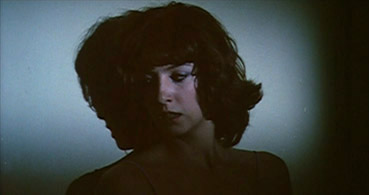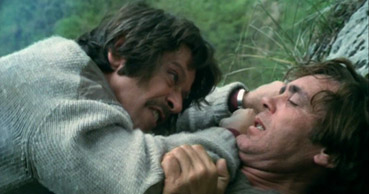|
A chemist is murdered in his pharmacy just as he is closing up for the night. By chance, cabaret performer Mara is going past with a headache and wants to buy some aspirin, but the killer won't let her in. A short while later she discovers the pharmacist's body but is spirited away by her male companion, who doesn't think they should get involved in such things.
Mara soon gets back to normal life and her dodgy stage act, while budding screenwriter Carlo and his director Michele try to woo her for a part in their new production. Her evening is made when old friend Lukas turns up after a six month absence. She's glad to see him, but not glad enough to let him climb into her pants. At least not yet. But when someone gets into her apartment that night and is only frightened off by chance, she thinks again. Maybe moving in with Lukas wouldn't be a bad idea after all. After all, he's got a moustache and he smokes cigars.

Living in the same building is Giovanni Bozzi, who that day has invited his friend Esmeralda to visit. The pair haven't been at his place long before Giovanni gets the latest in a series of threatening phone calls made up largely of overlapped sounds that the caller claims have specific meaning for him. Giovanni has taken to taping these calls and takes this latest one to Lukas, who transports him to a sound studio and has his techie chum attempt to isolate the individual sounds. It's right here that Watch Me When I Kill (Il Gatto dagli occhi di giada, or The Cat With the Jade Eyes, aka The Cat's Victims) shows the first real signs that it might be more than the average giallo thriller. The idea is borrowed from Coppola's The Conversation (1974), but the results remain inconclusive enough to prevent anyone without psychic powers from guessing the ending.
Esmeralda, meanwhile, has gone home and is preparing dinner when someone creeps in and pushes her face into the oven-hot food. When the severe burning fails to finish her off, the intruder takes a knife to her face. And before you cross the film off your viewing list on the basis of how this must look on screen, know that while the face in the food is shown in full, the follow-up is all quick edits and suggestion. In spite of its sensationalist English title, Watch Me When I Kill rarely dwells on its violence and employs it primarily to build tension and provide a reason for Lukas and Mara to start investigating the murders. After all, with little sign of the police doing likewise, someone else might as well have a go. But while initially driven by a fear that Mara was a potential target, Lukas soon starts to suspect that the killings may not be as random as was first thought.
Watch Me When I Kill may not go blood crazy in its killings, but otherwise ticks all the right giallo buttons. Particularly impressive are the attacks and their build-up, small pockets of mounting tension constructed from savvy camera angles, nifty editing and a super-giallo music score. Actually the score really does deserve a special mention, being the work of a group who call themselves Trans Europa Express. They've done a number of film scores in their time, the number in question being one, and this is it. Research has failed to turn up anything on their makeup, but ten minutes in I began to suspect they were actually members of Goblin moonlighting under a pseudonym. Either way, the influence of Goblin's scores for Dario Argento is unmistakable, with elements of the music from Deep Red blended with chants that seem to have been lifted wholesale from Suspiria. And before someone picks me up on the release dates, Suspiria had its Italian premiere in February 1977, while Watch Me When I Kill wasn't released until August of the same year, and given that the score is one of the last components added to most films that leaves plenty of time for skilled musicians to go a-borrowing. But this is no second-rate Goblin knock-off but a score to stand alongside their best work, an unsettling and musically arresting accompaniment that proves a key element of director Antonio Bido's screw tightening.

Characters do occasionally behave in a manner unique to giallo logic, making decisions on nothing more than a sudden whim and at times as if they're watching the very film they're in (no sooner have we been visually clued in to the possibility that Lukas and Mara have the wrong suspect than Mara pipes up out of nowhere "Suppose he isn't the murderer!" and Lukas immediately remembers something to substantiate her brainstorm). But for the most part this is a tightly plotted piece in which the motivation for murder proves to have considerably more weight than the genre norm.
Watch Me When I Kill is a giallo thriller with a touch of class. It shines in its set-pieces (a rapid-cut bathtub murder set to Verdi's Dies Irae is a highlight) but also delivers on its story and resolution. Lukas may be a bit of a sleaze but his heart's in the right place, while the supporting cast are interesting enough for us to back his efforts anyway. The film also benefits from an better than usual English dub that intermittently makes you forgot this is actually an Italian film. And just occasionally director Bido's original desire to make a more art-house movie shows through, particularly in the window that falls quietly from an old building in which Lukas just has been pestered by a babbling madman, or when our hero visits and old people's home and encounters a woman singing opera to an audience of sleeping elderly women, an image almost worthy of a playful David Lynch.
The disc features a brief introduction from director Antonio Bido, who hopes you'll enjoy the film and describes the transfer here as "beautiful." I wouldn't go quite that far. I have little doubt that it's a considerable improvement on past tape copies, but the source print still betrays some variable contrast levels (though at best they are very good) and sometimes iffy colour, with a brown/green tinge present in some sequences and detail a touch soft. This is, we are assured by director Bido himself, no fault of Shameless's transfer, but the result of his one-off use of Agfa-Gevaert stock, which had a more faded and washed-out look than the Kodak equivalent and whose colours and definition have faded over time, for which Bido sincerely apologises. This is thus likely as good as the film is ever likely to look on home video – it's a clean print and the picture is stable, and despite the odd smattering of compression artefacts (although this seems to be dependent on the player/TV combination) this is a decent enough job. The transfer is framed approximately 1.90:1 and anamorphically enhanced.

The mono soundtrack crackles a little at times but is generally clean and clear. The film was shot in stereo and in the accompanying interview Bido talks enthusiastically about the importance of the stereo soundtrack and is saddened by its loss. As mentioned above, the English dub is rather good and is convincingly mixed with the rest of the background sound. A trace of the original stereo track's fidelity can be detected in the music, which has rather good clarity and bass, even with the subwoofer switched off.
Fact Track
Another of Shameless's textual fact tracks, this time supplied by the Wilson Brothers, who have written some excellent DVD reviews over at the Region 2 Project. For those new to this type of feature, you play the film with the track engaged and subtitles intermittently appear to comment on the production, those involved or a particular scene. Like its predecessors, this is a hit-and-miss affair, with some long pauses between the subtitles and a few too many 'funny' comments about the on-screen action, characters, props and dialogue, the sort of remarks you hear twerps making in cinemas in an effort to impress their mates. Facts are forthcoming, but you'll need some patience if you're going to wait for them all.
Watch Me When I Tell (19:50)
Director Antonio Bido talks at speed (in Italian with English subtitles) about the development of the film and his involvement in it, the decision to use Gevaert stock and the resulting longevity issues, the now lost stereo soundtrack, his refusal to add gratuitous sex scenes, the rediscovery of his work by a new generation and a whole lot more. He talks at some length about the bathtub scene, which is his personal favourite and the only one directly influenced by the work of another filmmaker (the Argento references were, he assures us, at the behest of the more commercially minded producers). I have to say I learned a lot more about the film and its director from this than I did from the fact track.
Two trailers are also included and are all in rather good shape. The International Trailer (3:26) is under the title of The Cat's Victims and has a somewhat broken mirror structure, while the American Trailer (2:09) is backed by music not from the film and sports an increasingly frantic voice-over that invites us to "witness a shattering adventure in total fright."
Adding to the completist feel are the International Titles (2:25), with The Cat's Victims credits running white on black as the sound from the now obscured image continues underneath, while the American Titles (0:40) differ starkly from the other versions and are placed at the very start of the film.
There's also a rolling Picture Gallery (2:00), a collection of front-of-house and production stills, posters and video covers.
An enjoyable and involving giallo thriller given very good fan-boy DVD treatment by Shameless on what probably ranks as their most feature-busy disc yet. It's also nice to see the filmmaker himself involved in the process and providing his stamp of approval. Cool.
|